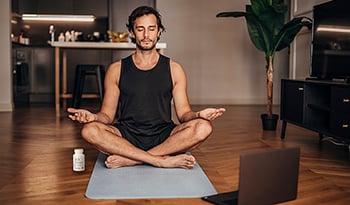4 Best Healthy Habits to Practice Daily According to a Naturopathic Doctor
DISCLAIMER:This blog does not intend to provide diagnosis...
- In this article:
- 1. Optimize Circadian Rhythm
- 2. Stay Hydrated
- 3. Move 30 Minutes Daily
- 4. Track Macros and Micros
- The Bottom Line

There’s nothing like a daily routine to get us into good habits. Habits enable us to be more focused, create good work-life boundaries, fuel our bodies, and nourish our spirits. And when you don’t have to think about what you’ll do each day, it leaves more mental space to focus on things that bring you joy.
Today, I’m sharing my top four healthy habits to help you get into a groove so you can feel great, too.
1. Optimize Circadian Rhythm
Good sleep is good medicine. Solid research shows that getting enough sleep can reduce the risk of infectious diseases and inflammatory issues like cardiovascular disease, mood issues like depression, and even chronic disease.1
Sleep is one of the best—and cheapest—things you can do to live longer. So, I focus on getting it right!
The key to hacking sleep and circadian rhythm and making them work for you is understanding that when you sleep is as important as how much time you sleep each night. For example, did you know that your body produces most of its melatonin between 10 pm and 2 am? Or that this is also the optimal window for deep sleep, which is when your tissues heal and regenerate?
Sleep Timing
Melatonin is a major antioxidant. Not only is it linked to serotonin and good sleep, but as an antioxidant, melatonin is linked to longevity, immune function, hormone regulation, and more.
I prioritize falling asleep by 10 pm so I can take advantage of my natural circadian rhythm and produce the peak melatonin amount my body is capable of each day. I’ve benefited from this in the form of less inflammation, better mood, and better recovery.
I also try to ensure I sleep eight hours per night and rely on a sleep tracker to keep me accountable.
Sleep Tracking
In the clinic, we often say, “If you don’t track it, you can’t know!” A wearable tracking device can report back on the phases of sleep your body goes through each night and total time asleep. Once you understand your deficits, you can work with your practitioner to find the best treatments.
As a bonus, wearable trackers also provide you and your practitioner with vast information about your health, including movement, steps, heart rate, biometrics, and more.
Energize in the Morning
Going to bed at an optimal time is the start. Rising with the sun is also a good practice to help your body sync its own natural circadian rhythm to that of the planet. Naturopathic doctors frequently recommend getting outside for the first 15 minutes of the day to take some good, deep breaths and let your eyes see the sunlight first thing in the morning. The blue light of the sky helps turn off sleep hormones and turn on energizing daytime hormones that give you energy, control inflammation, and optimize hormone production.
Another of my favorite routines is taking B vitamins in the morning for their positive effect on energy.2
Need more? Take a deep dive into more tips for resetting your sleep schedule here.
2. Stay Hydrated
Your blood delivers oxygen and every single nutrient your cells need to your tissues, brain, and organs each day. You probably suspected that your blood is made from fluid, but did you know most of that fluid comes from the water and liquids you drink?
The water contained in blood is called plasma.3 Plasma is actually closer to the concentration of seawater than it is to tap water.4 If you’ve ever had an IV, you’ll recall that it’s generally sodium and chloride. It also contains electrolytes, vitamins, and nutrients like glucose and amino acids.3
I try to consume fluid as similar to plasma as possible so my body doesn’t have to do the hard work of stealing electrolytes from my tissues to create balanced fluid in my cardiovascular system. This means consuming water that’s premixed with electrolytes and sometimes even protein. It’s paid off by helping me feel more energized and happy and helps improve my recovery from workouts so I get the major benefits of exercise without the downsides.
To get more electrolytes, I add trace minerals every time I fill my water bottle. (Fun fact—minerals and electrolytes are actually the same thing!)
Because I track my food and nutrient intake, I know I struggle to consume enough potassium and magnesium most days unless I take a supplement. So, I have my own back by finding yummy ways to include them in my daily routine.
There are many easy ways to get electrolytes. Talk to your practitioner about which of the following options is best for you and how often you should take them:
- Liquid Electrolytes: Liquids can go right in your water bottle. You can also reconstitute many liquid electrolytes into a larger container so they’re ready when you are.
- Powders: Powdered forms come in easy-to-carry (to the gym!) sticks and packets, as well as in money-saving containers. Simply add to your water bottle and shake. These are convenient for when you’re on the go.
- Electrolyte Pills: Pills are an excellent option for those who don’t really want to taste their electrolytes—even if they’ve been flavored. Just be sure to drink plenty of water each time you take a pill.
- Effervescent Tabs: Effervescent tabs fizz up when dropped into water. They come in handy portable packs and are another great choice when you’re on the move.
In general, my clients take electrolytes in the morning and during workouts. If they opt for pills, I suggest they take them with a meal. I also recommend that clients take electrolytes when they feel unwell, especially if they’re losing fluid through vomiting or diarrhea or if they have a fever.
Electrolytes can be dangerous if you have a cardiac condition or serious health issue or take certain medications. Always chat with your doctor before adding them to your routine.
3. Move 30 Minutes Daily
Before you think, “I don’t/can’t exercise,” read on! Moving 30 minutes a day doesn’t have to mean going to the gym. Moving 30 minutes a day means just that—getting yourself in motion and your heart rate up! You can do it in a way that brings you joy and includes lots of music or family time. Getting creative is the key to enjoying exercise, and it’s important that you do it. Exercise is linked to longevity and can boost immunity, too.
The American Heart Association has been making the heart-healthy recommendation to exercise 150 minutes per week for decades—because it works.5 Your heart delivers blood throughout your body. That blood carries oxygen and nutrients to every tissue in your body—that means your hard-working organs like the brain, liver, and kidneys, plus your skin, nails, and hair.
You can see why getting your move on is essential.
You’ll want to check in with your practitioner before starting any movement routine, especially if you have existing medical conditions. How you move will depend on your specific goals. Some of my recommendations to my clients include:
- Cardiovascular Health: For a healthy heart, practice HIIT (high-intensity interval training), sports, walking, jogging, running after your kids or pets, or dancing. These types of exercise pair well with music or friends. If you have kids or grandkids, chances are they’ll love to get in on playing sports with you!
- Flexibility: To stay limber, choose yoga or Pilates. These focus on lengthening and strengthening muscles, ligaments, and fascia. Yoga also has a meditative mind-body link, while Pilates improves core and muscle strength.
- Muscle and Bone Strength: For muscle and bone mass, learn to weight lift—and lift heavy if you can! Heavy lifting has been shown to build bones and can even reverse osteopenia and osteoporosis. There are many ways you can learn to lift, and they don’t have to be expensive. Shop around among the gyms near you and look for ones that offer instruction so you learn the correct form. A personal trainer is also an option. And remember, you’ll need more protein and minerals to support your bones and metabolism during weight lifting.
- Mental Boost: For general health benefits, with an added dose of joy, try dancing, hiking, or ice skating with friends. Most of those activities are free or low-cost. Exercise does not have to be in the gym!
And remember—now that you know all about adding water to your routine—stay hydrated before, during, and after exercise.
4. Track Macros and Micros
Remember the saying, “If you don’t track, you can’t know?” It’s not just good advice for sleep—it’s also good advice for what you eat. Awareness of what you consume is important because it reveals the gaps that you have to fill. It’s especially important to look at your macros and micros.
Macronutrients are proteins, carbohydrates, and fats and are the basic building blocks of a good nutrition plan. Getting enough of these makes it possible to have good energy, a healthy metabolism, build muscle, and strengthen bones.
Micronutrients, like B vitamins, vitamin D, and vitamins A, C, and E, give us energy, keep skin looking radiant, and fuel the metabolism. Minerals help keep us calm, may improve our mental health, and help us with workout recovery.
You can track your nutrient intake or work with a practitioner who can do it for you to reveal which nutrients you may need more of.
My health habit—I track every day. And because I track, I know that while my diet is fairly replete, I have room to improve with my choline intake. This makes sense because I can’t eat eggs due to an allergy—and eggs are a top source of choline. I also sometimes forget my choline supplement at night, and the data shows me it has consequences for my health when I do.
The information I get from tracking helps me realize that I have to get back on track with taking my supplement or switch it to a different form or time of day that will allow me to be more consistent. The same goes for iron, iodine, calcium, and potassium, which tend to be a bit low in my daily intake.
One strategy I might use is keeping my choline supplement next to my multivitamin, which is out on the counter for me to take after breakfast. In a few months of being consistent with this change, I should see that the choline number get to 100%!
Your practitioner will work with you to determine the best tracker, as well as how to fill the gaps in your nutrition plan with foods and supplements.
This is important: Don’t track if you have a history of an eating disorder, as it can be triggering. Instead, work with a qualified medical professional to determine what gaps you have to fill.
This habit works for me, but it may not work for you. The takeaway here should be that paying attention to your health can pay off by revealing the areas of your diet you actually need to pay attention to. I like practicing evidence-based nutrition rather than following a random set of standards or rules.
If you don’t track, you can’t know!
The Bottom Line
Taking care of yourself is job one, especially if you have others to care for, from littles to significant others to parents. We all juggle many things in this life, and it’s our birthright to feel well-rested, hydrated, strong, and nourished. It’s our birthright to feel well.
There’s great news: A few daily healthy habits can make all the difference. They don’t have to take a long time or cost a lot of money, either. You can implement some on your own, like getting to bed on time for sound sleep, ensuring you get enough water, and starting to move your body. Others are best done with the help of a qualified practitioner who can advise on what macro and micros, types of exercise, and supplements would most benefit you and your lifestyle.
You can do it! For a detailed (hour-by-hour!) overview, check out my full daily regimen here!
References:
- Irwin, M. R. (2015). Why Sleep Is Important for Health: A Psychoneuroimmunology Perspective. Annual Review of Psychology, 66(1), 143–172. https://doi.org/10.1146/annurev-psych-010213-115205
- Hanna, M., Jaqua, E., Nguyen, V., & Clay, J. (2022). B Vitamins: Functions and Uses in Medicine. The Permanente journal, 26(2), 89–97. https://doi.org/10.7812/TPP/21.204
- What does blood do? (2019, August 29). Nih.gov; Institute for Quality and Efficiency in Health Care (IQWiG). https://www.ncbi.nlm.nih.gov/books/NBK279392/
- Hematology Glossary. (2021). Hematology.org. https://www.hematology.org/education/patients/blood-basics
- American Heart Association Recommendations for Physical Activity in Adults and Kids. https://www.heart.org/en/healthy-living/fitness/fitness-basics/aha-recs-for-physical-activity-in-adults

 By Dr. Kate Henry, N.D.
By Dr. Kate Henry, N.D.


